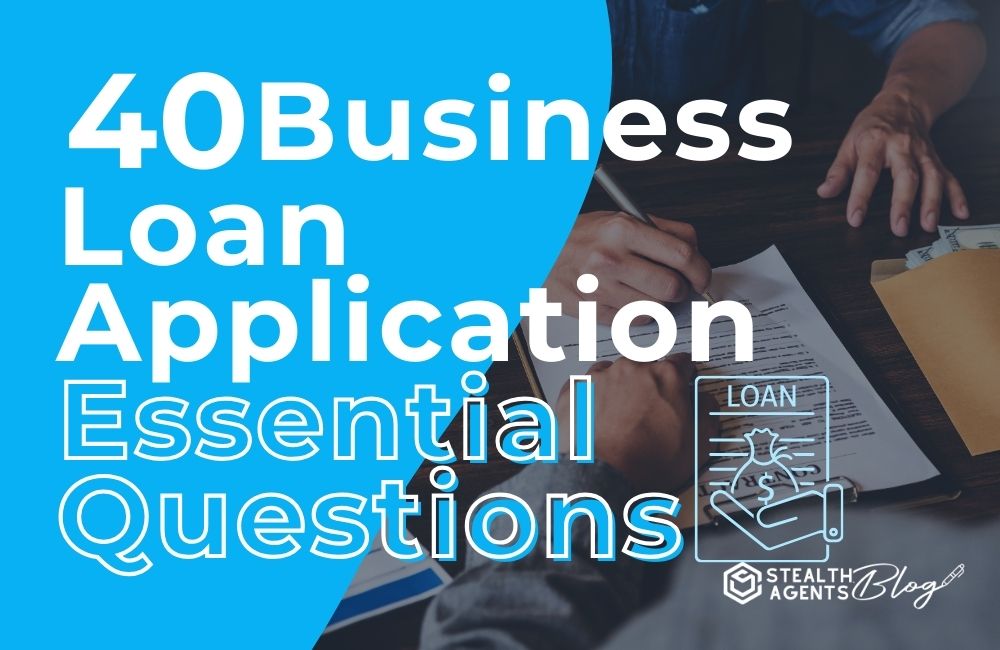Securing a business loan is a pivotal step for many entrepreneurs. Whether launching a startup, expanding operations, or managing seasonal cash flows, a loan can provide the financial boost needed to achieve business goals. However, navigating the application process can be complex, often involving a myriad of financial details, personal information, and business metrics.
To help you prepare for this journey, here’s a comprehensive list of 40 essential questions you should address when applying for a business loan. By diving into these details, you’ll not only be better equipped to fill out your application but also to identify areas of strength and potential improvement within your business operations.
Introduction
Before we dive into the nitty-gritty of business loan applications, it’s crucial to understand why these questions matter. Institutions that provide business loans are essentially taking a calculated risk on the growth and success of your venture. The more prepared and transparent you are, the more they can evaluate this risk in your favor.
Let’s break down this vital list of questions into detailed sections that cover everything from your business concept to your credit history, all of which can influence the outcome of your loan application.
Business Loan Application Essential Questions
1. Business Concept and Operations
Begin with a comprehensive overview of your business concept and how you plan to execute it. What differentiates you from the competition, and how do you anticipate market demand? Provide a clear business plan that outlines your goals, targets, and operations.
2. Market Analysis
Understand your demographic and competition within your market. What strategies have you implemented to stay ahead? Detail your findings and how they inform your business model.
3. Strategy for Expansion or Start-Up
Explain your strategy for growth. Is it realistic, and what are the indicators that suggest its feasibility? Paint a detailed picture of your expansion plan and anticipated outcomes.
4. Management Expertise
Dive into your management team’s experience. Who are they, and what expertise do they bring to the table? Loan providers want to know that companies are as good as their management.
5. Your Target Audience
Define your ideal customer and map out how you plan to reach them. A thorough understanding of who you’re selling to is critical for both internal strategy and for the confidence of lenders.
6. Marketing and Sales Plan
What is your marketing and sales strategy? This needs to be more than just hypothetical. Provide real metrics and performance data to back up your plan.
7. Operational Plan
Outline the nuts and bolts of your business’ daily operations. Show that you’ve thought through how your products and services will be made and delivered.
8. Financial Projections
What do your financial projections say? Lenders will want to see that you’ve done your homework. Your projections should be conservative, realistic, and clearly outlined.
9. Business Structure
Is your business a sole proprietorship, partnership, LLC, or corporation? Each structure impacts your tax obligations and legal responsibilities, which are crucial considerations for lenders.
10. Legal Obligations
Have you met your state’s requirements for business licensing and compliance? Lenders want to know you’re operating legally and with all necessary paperwork in order.
*advertisement*
Tired & Overwhelmed With Administrative Tasks?
Hire A Top 1% Virtual Assistant From Stealth Agents!

Sign Up Below & Hire A Top 1% Virtual Assistant
Rated 4.7 Stars Serving Over 2,000+ Customers.
Hire Top 1% Virtual Assistants For $10-$15 Per Hour
Ask About Our 14 Day Trial!
*advertisement*
11. Business Plan Documentation
This includes your business plan, any market studies, feasibility studies, etc. Detail and relevance matter, so ensure everything is up-to-date and crisply presented.
12. Mission and Vision Statement
What do you stand for, and what’s your big-picture goal? Clarity and alignment with your business narrative is key here.
13. Competitive Analysis
How do you stack up against competitors, and how will you maintain a competitive edge? Be specific with your SWOT analysis.
14. SWOT Analysis
What are your business’s strengths, weaknesses, opportunities, and threats? Show that you fully understand your business’s position in the market.
15. Intellectual Property Rights
Do you own essential trademarks, copyrights, patents, or other intellectual property? These can be critical for protecting and valuing your business assets.
16. Branding and Brand Strategy
Developing a strong brand can help secure customer loyalty and trust. How do you plan to achieve this, and what branding efforts have you put in place?
17. Online Presence
In today’s market, your online presence is as important as your physical footprint. How do you plan to maintain that presence, and what’s the strategy to engage online customers?
18. Technological Innovation
In which ways is technology integrated into your business, and how do you foresee it shaping your future strategy and bottom line?
19. Production and Supply Chain
Outline your production process and the nodes of your supply chain. A clear understanding of this is fundamental to meeting customer demand and mitigating risks, particularly for inventory-heavy businesses.
20. Risk Management
Details are crucial here. What insurance coverage do you have for your business, and what are its limitations? Show you’re fully aware of your business’s risks.
21. Financial Performance
How has your business performed financially over the past several years? Provide audited financial statements if you have them.
22. Tax Compliance
Are your taxes up to date and have all filings been submitted? This speaks to your business’s financial health and long-term stability.
23. Credit History
What is your personal and business credit history? Transparency is crucial here, including explaining any blemishes on your record.
24. Collateral Available
Do you have assets that you can pledge as collateral against the loan? Be aware of what you’re putting on the line and communicate this effectively to the lender.
25. Existing Debt Obligations
What are your existing debts, and how do they affect your cash flow? Lenders want to know that you can handle additional debt responsibly.
26. Business Equity
How much of your business do you already own, and how much equity are you willing to offer? This speaks to how much stake you have in the business.
27. How Much Funding Do You Need?
This speaks to the specifics of the loan size and term lengths that best fit your business’s current and future financial needs.
28. What Will The Funds Be Used For?
How you plan to allocate the funds is important. Lenders often look for investments in the business that will generate a return, such as expansion or equipment.
29. Term Length and Amortization Schedule
Do you understand the difference between term length and amortization schedule, and what best fits your business’s needs? Be prepared with a clear strategy for how you’ll repay.
30. Interest Rate Expectations
Are you shopping around for interest rates, or have you submitted to the first offer you’ve received? Demonstrating you have a knowledge of industry standards can be beneficial.
31. Bank Statement Analysis
Have you conducted an in-depth analysis of your business account statements? This should show your business’s financial health, typical cash flow, and patterns that could hint at any potential issues.
32. Industry and Economic Trends
How do industry trends and the larger economic climate impact your business? Stay informed and show that you have a finger on the pulse of your business environment.
33. Business Insurance Details
Provide the specifics of your business insurance, such as coverage types, amounts, deductibles, and whether the lender’s interest is included.
34. Incorporation Documents
Be prepared to provide articles of incorporation or organization and any amendments. This helps demonstrate that your business is properly structured.
35. Regulatory Compliance
Explain how your business complies with relevant industry regulations and standards. This information is crucial for lenders who want to see that your business operates in a safe and legal manner.
36. Business Licenses and Permits
Detail any necessary business licenses and permits required for your operations and ensure they’re fully accessible to the lender.
37. Bankruptcy and Litigation History
Provide a clear record of any past bankruptcy filings or current litigation involving your business. Being straightforward helps establish trust.
38. Business Valuation
How have you arrived at your business’s valuation? Whether based on market comparable sales, the income method, or the asset method, understanding this is critical for a lender.
39. Employment Details and HR Practice
Share details on your current employment numbers, your hiring practices, and your HR strategy. Your ability to manage human resources effectively is a key consideration for lenders.
40. Communication and Issues Resolution
How do you handle customer complaints and communication in your business? Any track record of issues and how you manage them is a direct testament to the strength of your operations.
Conclusion
Each of these questions delves into a specific area of your business and personal finances that lenders consider when evaluating your loan application. It’s not just about the numbers on the page, but about the story they tell of your business’s viability, potential, and stability. Take your time to address each question thoroughly, and don’t hesitate to reach out to your financial advisor or a loan specialist to ensure you’re putting your best foot forward.
Remember, the loan application process is an educational venture in itself. As you compile the documentation and answers to these questions, you develop a deeper understanding of your business’s strengths and areas for improvement. When it comes time to meet face-to-face with potential financiers, you’ll not only have the paperwork in order, but you’ll also exude confidence in your business’s journey toward growth and sustainability. Good luck! Your venture’s next chapter awaits with every detailed answer.










